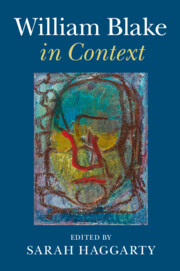Book contents
- William Blake in Context
- William Blake in Context
- Copyright page
- Contents
- Illustrations
- Notes on Contributors
- Acknowledgements
- Abbreviations
- Introduction
- Part I Life, Works, and Reception
- Part II Form, Genre, and Mode
- Part III Creative Cross-Currents
- Part IV History, Society, and Culture
- Further Reading
- Index
- References
Further Reading
Published online by Cambridge University Press: 23 March 2019
- William Blake in Context
- William Blake in Context
- Copyright page
- Contents
- Illustrations
- Notes on Contributors
- Acknowledgements
- Abbreviations
- Introduction
- Part I Life, Works, and Reception
- Part II Form, Genre, and Mode
- Part III Creative Cross-Currents
- Part IV History, Society, and Culture
- Further Reading
- Index
- References
- Type
- Chapter
- Information
- William Blake in Context , pp. 345 - 363Publisher: Cambridge University PressPrint publication year: 2019

